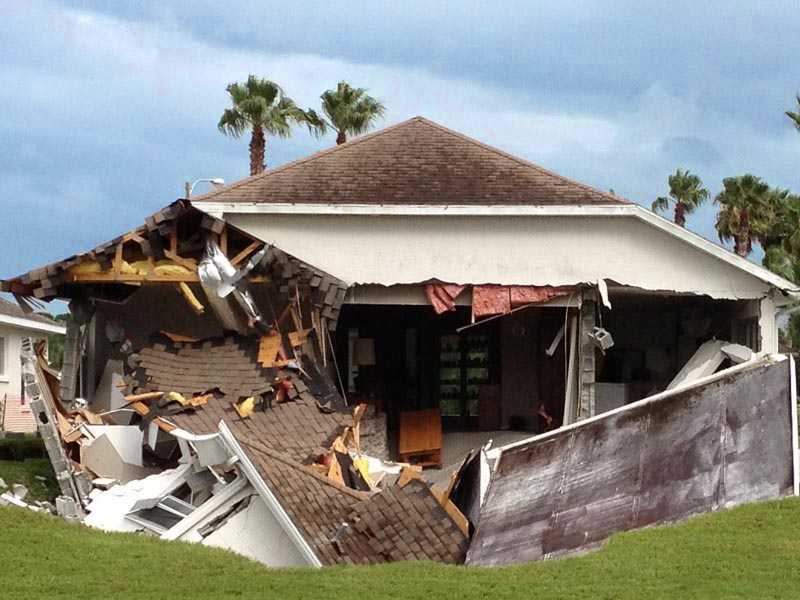Don’t let your savings ‘sink’ away due to a Sinkhole

Damage caused by sinkholes can be extensive, but may not always be covered by your homeowners policy. A standard homeowners insurance policy excludes “earth movement,” including sinkholes. That means you won’t be covered if a sinkhole damages your house or belongings. Learn more about how a sinkhole insurance policy may be right for you.
You can often find sinkhole coverage as an endorsement (sometimes called a rider) to a homeowners insurance policy, depending on your insurance company.
Some states, such as Florida and Tennessee, require home insurance companies to offer sinkhole insurance as an optional coverage. But some insurance companies include sinkhole insurance as part of their policies.
What Protection Does Sinkhole Insurance Offer?
Homeowners policies that cover only catastrophic ground collapse will cover the cost of damage only under the following conditions:
The abrupt collapse of ground cover
A depression in the ground cover clearly visible to the naked eye
Structural damage to the building, including the foundation
The insured structure being condemned and ordered vacated by the government agency
If your home is damaged by a sinkhole, but does not meet all four criteria, your insurance policy may not pay for the damage unless you have sinkhole coverage. Sinkhole coverage covers the circumstance where soil ravels into fractures created in underground limestone, causing a home’s foundation to settle unevenly. Sinkholes are generally not visibly apparent until you notice damage.
If You Have a Sinkhole Insurance Claim
If a portion of your home has shifted or sunk due to ground cover collapse, or if a sinkhole has appeared on your property, immediately take the following steps:
Ensure the safety of your family and evacuate if necessary.
Secure or remove valuable possessions.
Notify CoverLink Insurance.
Notify your city or county building inspection department.
Mark the sinkhole or property with fencing, rope or tape to warn others of the danger. If someone is injured in the sinkhole, you could be liable.
@coverlink_insurance
Worried about loosing your house to a sinkhole? Don’t let your house, and savings slip away. Call us to learn more about Sinkhole coverage. #insurance
♬ original sound – CoverLink Insurance
Be Aware of the Danger
Sinkholes are land forms created by the sinking of soil, sediment or rock as underlying layers are dissolved by groundwater. Sinkholes are most common where the rock below the surface is karst terrain, which includes limestone, gypsum and dolomite. About 20% of the U.S. land surface is karst.
As the rock dissolves, spaces and caverns develop underground. Sinkholes usually form very slowly and little change is noticed over time, but they can form suddenly when a collapse occurs.
There are three major types of sinkholes:
Dissolution sinkholes. These occur in areas where there is little soil or vegetation over limestone or other bedrock. Water from rain and runoff trickle through crevices in the bedrock and dissolve it. Over time, a depression gradually forms.
Cover-subsidence sinkholes. These occur in areas where sand covers the bedrock. Individual grains of sand move downward into openings in the rock, gradually causing the land surface to sink. Like dissolution sinkholes, cover-subsidence sinkholes happen slowly.
Cover-collapse sinkholes. These occur in areas where the bedrock is covered by a significant amount of clay. These form similar to cover-subsidence sinkholes, but the cohesive nature of clay allows a “bridge” to form above an enlarging cavity. When the overlying cover material can no longer support its own weight, the layer collapses. This can happen abruptly and be catastrophic.
Sinkholes can be triggered by natural events, such as heavy or prolonged rainfall or periods of drought. But sinkholes can also be triggered by human activities, such as:
Adding weight above cavities. This includes housing development, construction of roadways or structures, and artificial ponds of water.
Overpumping existing water supply wells or drilling of additional wells in the area. This causes the water table to lower and leaves cavern roofs unsupported.
How to Spot Sinkholes
Sinkholes often develop gradually. If you live in a sinkhole-prone area, here are some signs to watch for:
Cracks developing around doors and windows
Doors and windows that don’t open and close properly
Deep cracks in the pavement, driveway and walkways
Interrupted plumbing or electricity due to a sinkhole that damages utility lines
A circular depression in your yard or nearby area
Slumping trees or fence posts
Previously buried items like a foundation or fence posts that have become exposed as the ground sinks
Formation of small ponds as rainfall accumulates
Openings in the ground where rainwater disappears
Vegetation that wilts and dies because water is drawn away by a sinkhole
Water well levels that drop suddenly
Muddy or cloudy well water
When Purchasing a Home
If you’re interested in purchasing a home in area where sinkholes are a common occurrence, be sure to:
Verify that sinkhole coverage is included in your policy as a rider.
Hire a home inspector who can help you identify signs of potential sinkhole activity.
If you’re concerned the sinkhole could affect service lines, such as gas, sewer and water, contact your utility companies.
Contact your state geological survey for additional guidance.
Consider consulting with a professional land surveyor, hydrologist, geologist or geotechnical engineer to help mitigate damage. Here’s a list of professional organizations.
Contact CoverLink Insurance today if you have any questions about Sinkhole Insurance.



